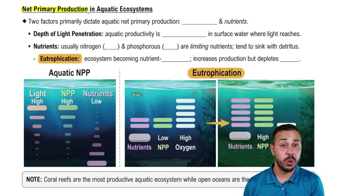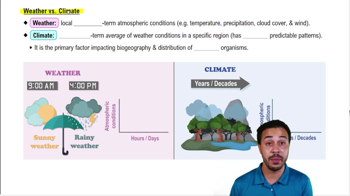Table of contents
- 1. Introduction to Biology2h 40m
- 2. Chemistry3h 40m
- 3. Water1h 26m
- 4. Biomolecules2h 23m
- 5. Cell Components2h 26m
- 6. The Membrane2h 31m
- 7. Energy and Metabolism2h 0m
- 8. Respiration2h 40m
- 9. Photosynthesis2h 49m
- 10. Cell Signaling59m
- 11. Cell Division2h 47m
- 12. Meiosis2h 0m
- 13. Mendelian Genetics4h 41m
- Introduction to Mendel's Experiments7m
- Genotype vs. Phenotype17m
- Punnett Squares13m
- Mendel's Experiments26m
- Mendel's Laws18m
- Monohybrid Crosses16m
- Test Crosses14m
- Dihybrid Crosses20m
- Punnett Square Probability26m
- Incomplete Dominance vs. Codominance20m
- Epistasis7m
- Non-Mendelian Genetics12m
- Pedigrees6m
- Autosomal Inheritance21m
- Sex-Linked Inheritance43m
- X-Inactivation9m
- 14. DNA Synthesis2h 27m
- 15. Gene Expression3h 20m
- 16. Regulation of Expression3h 31m
- Introduction to Regulation of Gene Expression13m
- Prokaryotic Gene Regulation via Operons27m
- The Lac Operon21m
- Glucose's Impact on Lac Operon25m
- The Trp Operon20m
- Review of the Lac Operon & Trp Operon11m
- Introduction to Eukaryotic Gene Regulation9m
- Eukaryotic Chromatin Modifications16m
- Eukaryotic Transcriptional Control22m
- Eukaryotic Post-Transcriptional Regulation28m
- Eukaryotic Post-Translational Regulation13m
- 17. Viruses37m
- 18. Biotechnology2h 58m
- 19. Genomics17m
- 20. Development1h 5m
- 21. Evolution3h 1m
- 22. Evolution of Populations3h 52m
- 23. Speciation1h 37m
- 24. History of Life on Earth2h 6m
- 25. Phylogeny2h 31m
- 26. Prokaryotes4h 59m
- 27. Protists1h 12m
- 28. Plants1h 22m
- 29. Fungi36m
- 30. Overview of Animals34m
- 31. Invertebrates1h 2m
- 32. Vertebrates50m
- 33. Plant Anatomy1h 3m
- 34. Vascular Plant Transport2m
- 35. Soil37m
- 36. Plant Reproduction47m
- 37. Plant Sensation and Response1h 9m
- 38. Animal Form and Function1h 19m
- 39. Digestive System10m
- 40. Circulatory System1h 57m
- 41. Immune System1h 12m
- 42. Osmoregulation and Excretion50m
- 43. Endocrine System4m
- 44. Animal Reproduction2m
- 45. Nervous System55m
- 46. Sensory Systems46m
- 47. Muscle Systems23m
- 48. Ecology3h 11m
- Introduction to Ecology20m
- Biogeography14m
- Earth's Climate Patterns50m
- Introduction to Terrestrial Biomes10m
- Terrestrial Biomes: Near Equator13m
- Terrestrial Biomes: Temperate Regions10m
- Terrestrial Biomes: Northern Regions15m
- Introduction to Aquatic Biomes27m
- Freshwater Aquatic Biomes14m
- Marine Aquatic Biomes13m
- 49. Animal Behavior28m
- 50. Population Ecology3h 41m
- Introduction to Population Ecology28m
- Population Sampling Methods23m
- Life History12m
- Population Demography17m
- Factors Limiting Population Growth14m
- Introduction to Population Growth Models22m
- Linear Population Growth6m
- Exponential Population Growth29m
- Logistic Population Growth32m
- r/K Selection10m
- The Human Population22m
- 51. Community Ecology2h 46m
- Introduction to Community Ecology2m
- Introduction to Community Interactions9m
- Community Interactions: Competition (-/-)38m
- Community Interactions: Exploitation (+/-)23m
- Community Interactions: Mutualism (+/+) & Commensalism (+/0)9m
- Community Structure35m
- Community Dynamics26m
- Geographic Impact on Communities21m
- 52. Ecosystems2h 36m
- 53. Conservation Biology24m
48. Ecology
Introduction to Ecology
Problem 4c
Textbook Question
The oceans affect the biosphere in all of the following ways except a. producing a substantial amount of the biosphere's oxygen. b. removing carbon dioxide from the atmosphere. c. moderating the climate of terrestrial biomes. d. regulating the pH of freshwater biomes and terrestrial groundwater.
 Verified step by step guidance
Verified step by step guidance1
Identify the role of oceans in the biosphere: Oceans play a crucial role in various global processes including the production of oxygen through photosynthesis by marine plants and phytoplankton.
Analyze the impact of oceans on atmospheric gases: Oceans help in sequestering carbon dioxide from the atmosphere, which is a critical process in regulating Earth's climate.
Consider the influence of oceans on climate: The vast body of water in the oceans absorbs and distributes solar energy, thereby moderating the climate of nearby terrestrial biomes.
Evaluate the statement about pH regulation: Understand that oceans primarily influence the pH of marine environments and have limited direct impact on the pH of freshwater biomes and terrestrial groundwater.
Determine the incorrect statement: Based on the understanding of oceanic influences, identify which option does not accurately represent the role of oceans in affecting the biosphere.
Recommended similar problem, with video answer:
 Verified Solution
Verified SolutionThis video solution was recommended by our tutors as helpful for the problem above
Video duration:
1mPlay a video:
Was this helpful?
Key Concepts
Here are the essential concepts you must grasp in order to answer the question correctly.
Oxygen Production
Oceans are vital for oxygen production, primarily through the process of photosynthesis carried out by phytoplankton. These microscopic organisms convert carbon dioxide and sunlight into oxygen, contributing to approximately 50% of the Earth's oxygen supply. This process is essential for the survival of aerobic organisms, including humans.
Recommended video:
Guided course

Primary Production in Aquatic Ecosystems
Carbon Dioxide Absorption
The oceans play a crucial role in regulating atmospheric carbon dioxide levels by absorbing significant amounts of this greenhouse gas. This process helps mitigate climate change by reducing the concentration of carbon dioxide in the atmosphere, which is essential for maintaining global temperature balance and supporting life on Earth.
Recommended video:
Guided course

Carbon
Climate Moderation
Oceans influence the climate of terrestrial biomes by acting as heat reservoirs and distributing heat through ocean currents. This moderation of temperature helps stabilize weather patterns and can affect precipitation and seasonal changes in nearby land areas, thereby impacting ecosystems and biodiversity.
Recommended video:
Guided course

Weather vs. Climate

 2:54m
2:54mWatch next
Master What is Ecology? with a bite sized video explanation from Jason Amores Sumpter
Start learningRelated Videos
Related Practice































































































